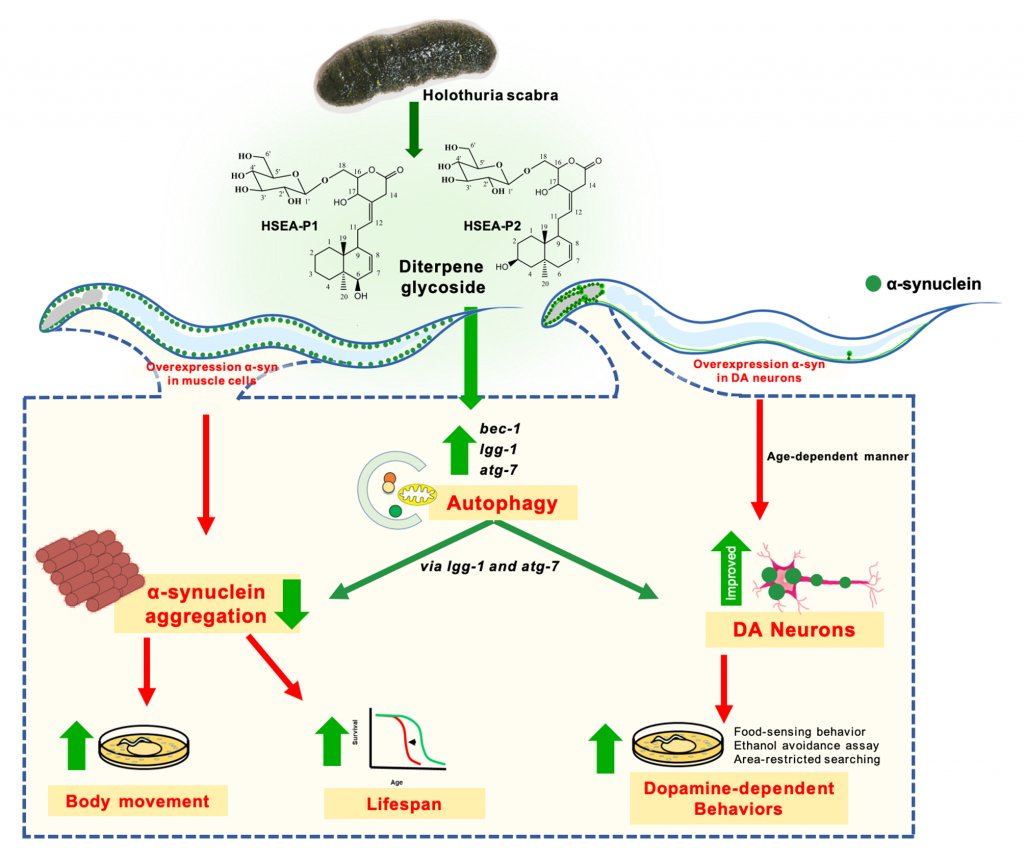
ฤทธิ์ของ diterpene glycosides จากปลิงทะเลขาวในการสลายโปรตีนแอลฟ่าซิลนิวคลีอินและป้องกันเซลล์ประสาทจากการถูกทำลายในสัตว์ทดลองต้นแบบ C. elegans
Highlight:
สารสกัด diterpene glycosides จากปลิงทะเลขาว สามารถลดการสะสมของโปรตีน α-synuclein และป้องกันเซลล์ประสาทสร้างโดปามีนจากการถูกทำลายด้วยโปรตีน α-synuclein ที่สะสมมากเกินไปในโรคพาร์กินสัน โดยมีกลไกการออกฤทธิ์ ผ่านทางยีน lc-3/lgg-1 และ atg-7/atg-7 ในกลไก autophagy
ที่มาและความสำคัญ
ปลิงทะเลขาวมีคุณค่าทางอาหารและมีประโยชน์ต่อสุขภาพมายาวนาน โดยผลงานวิจัยเมื่อเร็วๆ นี้พบว่าสารสกัดหยาบของปลิงทะเลขาวมีฤทธิ์ป้องกันเซลล์ประสาทในโรคพาร์กินสันได้ ดังนั้นการศึกษาวิจัยนี้จึงได้ทำการสกัดแยกสาร diterpene glycosides จากปลิงทะเลขาวและนำมาทดสอบศักยภาพในการลดการสะสมของโปรตีน a-synuclein และป้องกันเซลล์ประสาทจากการถูกทำลายด้วยโปรตีน a-synuclein ที่สะสมมากเกินไป ซึ่งเป็นสาเหตุหลักในการเกิดโรคพาร์กินสัน โดยใช้ C. elegans เป็นสัตว์ทดลองต้นแบบ ผลการศึกษาพบว่าสาร diterpene glycosides จากปลิงทะเลขาวสามารถลดการสะสมของโปรตีน a-synuclein เพิ่มอัตราการเคลื่อนไหวและอายุขัยของสัตว์ทดลองที่สูญเสียไปจากโปรตีน a-synuclein ที่สะสม นอกจากนี้สาร diterpene glycosides ยังสามารถป้องกันเซลล์ประสาทสร้างโดปามีนจากพิษที่เกิดจากโปรตีน a-synuclein ที่สะสมมากเกินไป และฟื้นฟูพฤติกรรมของสัตว์ทดลองจากระดับโดปามีนที่เพิ่มสูงขึ้นหลังจากได้รับสาร diterpene glycosides ผลการวิจัยเชิงลึกยังพบว่าสาร diterpene glycosides สามารถเพิ่มการแสดงออกของยีนที่เกี่ยวข้องกับกลไก autophagy เช่น beclin-1/bec-1, lc-3/lgg-1 และ atg-7/atg-7 ซึ่งเมื่อยืนยันด้วยการศึกษาโดย RNA interference พบว่าทั้ง lc-3/lgg-1 และ atg-7/atg-7 เกี่ยวข้องกับการสลายโปรตีน a-synuclein ที่สะสมและป้องกันเซลล์ประสาทสร้างโดปามีนจากการถูกทำลายด้วยโปรตีน a-synuclein ที่สะสมมากเกินไป
Abstract
Ethnopharmacological relevance
Holothuria (Metriatyla) scabra Jaeger (H. scabra), sea cucumber, is the marine organism that has been used as traditional food and medicine to gain the health benefits since ancient time. Although our recent studies have shown that crude extracts from H. scabra exhibited neuroprotective effects against Parkinson’s disease (PD), the underlying mechanisms and bioactive compounds are still unknown.
Aim of the study
In the present study, we examined the efficacy of purified compounds from H. scabra and their underlying mechanism on α-synuclein degradation and neuroprotection against α-synuclein-mediated neurodegeneration in a transgenic Caenorhabditis elegans PD model.
Material and methods
The H. scabra compounds (HSEA-P1 and P2) were purified and examined for their toxicity and optimal dose-range by food-clearance and lifespan assays. The α-synuclein degradation and neuroprotection against α-synuclein-mediated neurodegeneration were determined using transgenic C. elegans model, Punc-54::α-syn and Pdat-1:: α-syn; Pdat-1::GFP, respectively, and then further investigated by determining the behavioral assays including locomotion rate, basal slowing rate, ethanol avoidance, and area-restricted searching.
The underlying mechanisms related to autophagy were clarified by quantitative PCR and RNAi experiments.
Results
Our results showed that HSEA-P1 and HSEA-P2 significantly diminished α-synuclein accumulation, improved motility deficits, and recovered the shortened lifespan. Moreover, HSEA-P1 and HSEA-P2 significantly protected dopaminergic neurons from α-synuclein toxicity and alleviated dopamine-associated behavioral deficits, i.e., basal slowing, ethanol avoidance, and area-restricted searching. HSEA-P1 and HSEA-P2 also up-regulated autophagy-related genes, including beclin-1/bec-1, lc-3/lgg-1, and atg-7/atg-7. RNA interference (RNAi) of these genes in transgenic α-synuclein worms confirmed that lc-3/lgg-1 and atg-7/atg-7 were required for α-synuclein degradation and DAergic neuroprotection activities of HSEA-P1 and HSEA-P2. NMR and mass spectrometry analysis revealed that the HSEA-P1 and HSEA-P2 contained diterpene glycosides.
Conclusion
These findings indicate that diterpene glycosides extracted from H. scabra decreases α-synuclein accumulation and protects α-synuclein-mediated DAergic neuronal loss and its toxicities via lgg-1 and atg-7.
KEYWORDS: Parkinson’s disease, α-synuclein, Dopaminergic neuron, Caenorhabditis elegans, Holothuria scabra, Diterpene glycoside
Citation: Chalorak P, Sornkaew N, Manohong P, Niamnont N, Malaiwong N, Limboonreung T, Sobhon P, Aschner M, Meemon K*. Diterpene glycosides from Holothuria scabra exert the α-synuclein degradation and neuroprotection against α-synuclein-mediated neurodegeneration in C. elegans model. J Ethnopharmaco. 2021; 279:114347.
DOI: https://doi.org/10.1016/j.jep.2021.114347
RELATED SDGs:
SDG Goal หลัก ที่เกี่ยวข้อง
3. GOOD HEALTH AND WELL-BEING

SDG Goal ที่เกี่ยวข้องอื่น ๆ
14. LIFE BELOW WATER

ผู้ให้ข้อมูล: รองศาสตราจารย์ ดร.ไกร มีมล
ชื่ออาจารย์ที่ทำวิจัย: รองศาสตราจารย์ ดร.ไกร มีมล
ชื่อนักศึกษาที่ทำวิจัย: Pawanrat Chalorak
แหล่งทุนวิจัย: Royal Golden Jubilee Ph.D. scholarship (PHD/0137/2559), Mahidol University (Basic Research Fund: fiscal year 2021 – BRF2-NDFR27/2564), National Institute of Environmental Health Sciences R01ES10563 and R01ES07331
Tags: Caenorhabditis elegans, Diterpene glycoside, Dopaminergic neuron, Holothuria scabra, Parkinson’s Disease, α-Synuclein
